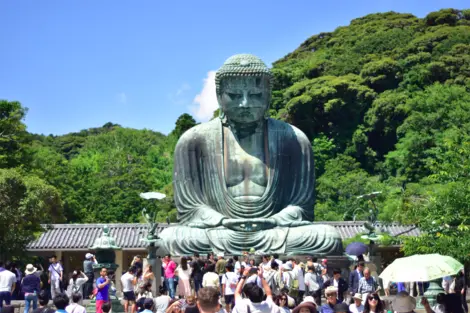The Kanto region 関東地方
- Published on : 05/05/2020
- by : J.R.
- Youtube
Kanto, the most populated region of Japan
A major region of Japan, home to the megalopolis of Tokyo and Yokohama, the Kanto region alone concentrates almost a third of the Japanese population! Very industrialized but also very touristy with countless places to visit and see, Kanto is an essential region to visit.
Where is the Kanto located?
Kanto, which is an unofficial geographical division, lies between the Tohoku region in the north and the Chubu region in the east. It is made up of seven prefectures: Chiba, Gunma, Ibaraki, Kanagawa, Saitama, Tochigi, and Tokyo. The largest cities in the region are Tokyo, Yokohama, Kawasaki, Saitama, and Chiba.
The Kanto extends south to Hakone, north to the city of Nasu. To the east, it is bordered by the Pacific Ocean at the prefectures of Chiba and Ibaraki. The region extends over more than 32,000 km2 and is home to approximately 43 million people. Kanto means "east of the barrier ".
Kanto history and culture
The Kanto is the nerve center of Japan. This is of course where the Japanese government and political institutions are located, but also a large number of universities, major museums, as well as many industries and businesses.
Historically, Kanto has always had an important place thanks to the presence of Edo, the former Tokyo. Kamakura, in the south of the region, was also the capital of Japan during the Kamakura period from 1185 until 1333. It was during this period that Kantô gained in importance compared to Kansai, which concentrates on Kyoto and Nara.
It is then Tokyo which will be the new capital from the start of the Edo period in 1868 and still is until today. The region was very marked in 1923 by the great earthquake, which caused extensive damage and more than 100,000 deaths.
- Read also: History of Japan: chronology
Today, Kanto is Japan's most developed, urbanized, and wealthiest region. It also concentrates a great tourist activity, mainly thanks to Tokyo, but also major sites such as Nikko and Kamakura.
The Kanto side of the kitchen: the Japanese cuisine of Tokyo
In terms of gastronomy, the Kanto is not left out either. Many culinary specialties were born there and then became popular throughout the archipelago, starting with the essential sushi, which needs no introduction.
The region has several preferences and specialties. For example, you will more likely find soba (buckwheat noodles) there than udon. If you want to try local specialties, you can try monjayaki, a type of okonomiyaki, or fukagawa-meshi (rice with clams). Tokyo will of course prove to be the ideal place to taste the best sushi.
- Read also: The culinary specialties of Kanto
What to visit in Kanto?
Kanto is above all Tokyo. But it is also magnificent natural sites, mountain ranges, ski resorts, beaches and historic villages, religious sites classified by Unesco, many ports and even volcanic islands...
You will discover below the main places, towns, and natural or cultural sites to visit when discovering this region:
Tokyo, the capital: Unsurprisingly, the fascinating Japanese capital is the heart of a stay in Japan. For more details and tips, see our dedicated Tokyo page.
To dive into the secrets of the Japanese capital, also discover our guide, " Tokyo, the Ideal Guide ".
Kamakura: The perfect getaway near Tokyo, to enjoy the joys of the beach, discover many temples and the famous Buddha.
Enoshima: Not far from Kamakura, the Enoshima peninsula is a refreshing visit, in a peaceful and oceanic setting.
Nikko: The temples of Nikko are classified as World Heritage by Unesco: a visit to Nikko, north of Tokyo, is recommended in all the best guides.
Mount Takao: Easily accessible from Tokyo, Mount Takao, and its various hiking trails allow you to admire Mount Fuji.
Mount Nokogiri and Chiba: In Chiba prefecture, Mount Nokogiri and its huge Buddha are not to be missed. You will enjoy a magnificent view of Tokyo Bay and the discovery of the largest seated Buddha in Japan.
Hakone: Hakone and the whole surrounding area have a lot to offer: lakes, museums, forest hikes, or even its many onsens.
Yokohama: Often neglected, Yokohama nevertheless has serious arguments: a large Chinatown, the Sankei-en garden, or even the Instant Noodles Museum...
Mount Mitake: Accessible from Shinjuku, Mount Mitake allows you to immerse yourself in Japanese nature, in the heart of the immense Chichibu Tamakai National Park. In the same park, the Hatonosu Valley and the Tama River also offer lovely landscapes.
The Izu archipelago: Finally, often forgotten because it is a little more difficult to access, the Izu archipelago notably includes the islands of Izu-Oshima, Shikine-jima, and Nii-jima. These islands are ideal for lovers of beaches, surfing, as well as snorkeling, diving, and trekking.
These islands are all accessible by ferry, from the Takeshiba terminal, in 2 to 3 hrs. Complete change of scenery guaranteed when you arrive straight from Tokyo...
- Read also: Excursions around Tokyo






































